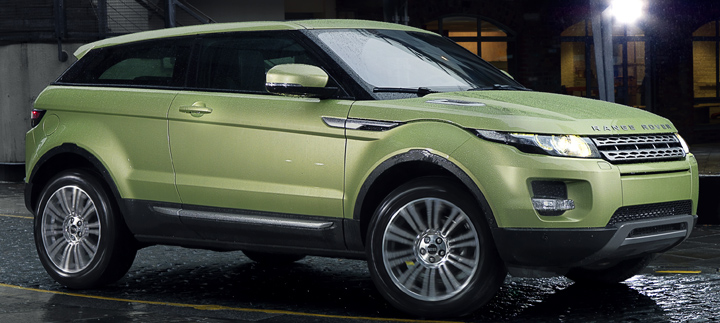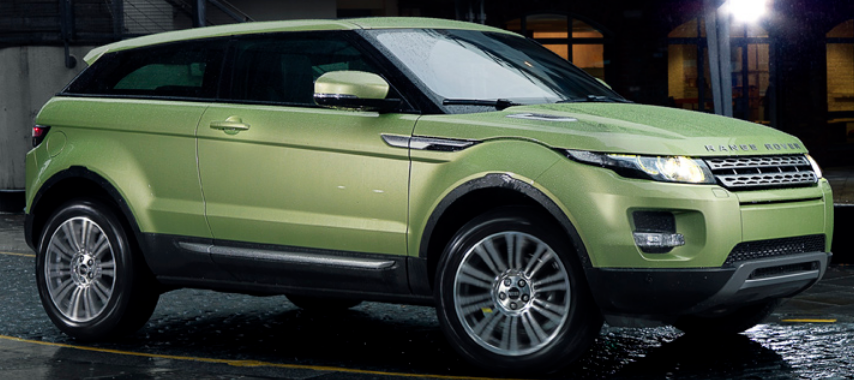
Note: This report supplements Consumer Guide Automotive’s full report on the 2012 Land Rover Range Rover Evoque, a premium-compact SUV that starts at $41,145.
Test Drive: 2018 Land Rover Range Rover Velar
Range Rover Evoque 2-Door
Test car came equipped with: Dynamic Premium Package, continuously variable shock absorbers, Climate Comfort Package, special paint, contrasting black roof, satellite/HD radio, and 20-inch chromed alloy wheels. Total MSRP including California emissions equipment and $850 destination charge = $60,095. (Note: This vehicle sees no significant changes for 2013).
Powertrain: 2.0-liter 240-horsepower turbocharged 4-cylinder engine, 6-speed automatic transmission, all-wheel drive.
Acceleration: Our friends at Car and Driver timed a top-line Prestige 4-door at 6.9 seconds 0-60 mph, which seems a shade optimistic. They also report top-gear incremental clockings of 3.7 seconds for 30-50 mph and 4.9 seconds for 50-70 mph, quite good for a two-ton SUV with 240 horses. Overall then, the Evoque has enough suds for most situations—at least with just a driver aboard. A sizeable load is sure to slow it somewhat. I agree with my colleagues that the 6-speed auto trans is responsive and, yes, occasionally “busy,” but I didn’t experience any abrupt or ragged shift action.
Cocktail-party trivia alert: The Evoque engine is basically Ford’s 2.0-liter EcoBoost unit available in the Explorer midsize SUV, the new 2013 Fusion midsize sedan, and the new Focus ST “hot hatch.” Range Rover obtains it from a Ford plant in Spain, rather than the U.S., to hold down manufacturing costs, although the transmission is sourced from Japan.
Fuel Economy: We averaged 21.4 mpg for some 195 miles of Phoenix-area driving divided pretty evenly between city and freeway driving. That’s not bad, all considered (the EPA ratings are 18/28 city/highway), but 22-23 would be preferable, seeing as how premium-grade fuel is required.
Ride Quality: As noted, this tester arrived with optional 20-inch wheels, like the press-preview Evoques my colleagues tried. The tires here were V-rated 245/45 Continental Cross Contact UHP. Agree with the main report that the “ride is firm, but never harsh,” but it is a bit turbulent, with more fore/aft pitch and lateral rocking than I expected, especially on generally smooth Arizona pavement. The car also tends to “clomp” over large bumps and potholes. All this betrays not only firm spring/shock-absorber calibrations but Land Rover’s typical extra-long wheel travel. And because of that, I suspect the ride would be little smoother on the standard 19-inch rubber.
Steering/handling/braking: I didn’t take this 2-door off-road, but I’ve seen James May drive an Evoque across Death Valley on the TV show Top Gear, and it did pretty well there. However, I can’t agree with my colleagues that the Evoque is “carlike and agile” on-road. To me it feels more like a truck, albeit a pleasant and, yes, unusually maneuverable one. I do concur with the steering comments. Braking is fine, as far I could tell, though pedal action seemed a touch grabby, as if the binders were somewhat over-boosted.
Quietness: Wind noise is generally well-checked, as the main report says, but it’s not entirely absent, thanks to the frameless door glass and, on the tester, an ill-fitting right-side body-mounted window seal. The large door mirrors probably contribute too. And yes, the amount of tire noise is disappointing, especially given my tester’s $60K delivered price.
Future Collectibles: 2017 Land Rover Range Rover Evoque Convertible
Details: Molded-plastic seat bases look rather low-grade, and the climate-control knobs and steering-wheel stalks felt slightly flimsy to me.
Room/comfort (front): The power driver’s seat has no vertical adjustment, and can be tilted up from the rear of the cushion but not from the front. To say the least, these omissions are quite odd for a premium-class vehicle, although they didn’t prevent this 6-footer from getting comfortable at the wheel. Perhaps only the 4-door version has “full-range” seat adjustments.
Room/comfort (rear): The problem is that the front seatbacks don’t tip ahead very far, so you usually have to power a front seat forward to create a decent-size entryway. Trouble is, the seats move at a glacial pace. A prospective rear occupant needs to wait a good 10-15 seconds before enough room opens up for squeezing in, which is hardly ideal if it’s raining. And if I recall correctly, it does rain a good deal in Great Britain, where the Evoque is made.
Cargo room: The Evoque has more packing space than you might think from looking at it, but it would have a bit more were it not for the sloping roof and liftgate. Also, the folded rear seatbacks don’t lay fully flat, and tripping their releases on the 2-door requires either a long reach from the rear bumper or a Plastic Man stretch from the doors.
CP Says The baby Rangie has been selling like scones at teatime, to the undoubted relief and delight of Land Rover accountants, and I’ll bet the 2-door is pulling in close to half the customers. Why? Because although the “coupe” version is bloody impractical, it turns heads like no SUV I’ve ever driven, except maybe for a Hummer H1. It probably helped that my tester was finished in an arresting shade called Colima Lime, with the optional (!) black roof adding drama.
But as much as I like the Evoque, even the 4-door, it’s expensive for what it is, and neither the high-fashion styling nor Range Rover’s brand cachet are enough to justify that in my mind. Still, if you’re a designer-label habitué with money to burn, knock yourself out. You probably won’t be disappointed. For everyone else there’s the new Ford Escape, arguably the second-best-looking SUV on the market.
